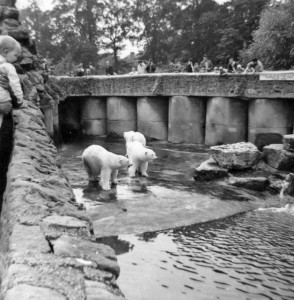Legislation
Requirements, Guidelines and Legislation
Over the years, the conditions in which polar bears are kept in zoos have drastically improved. Although some exhibits are now much improved from the concrete pits of the 1920’s, there is much debate over the idea that no matter how big the enclosure, we simply cannot provide an adequate “natural” environment for the well being of the polar bear. Over the years, with the help of scientists, welfare experts, zookeepers, and veterinarians, guidelines have been developed to ensure that bears which have no choice but to be kept in captivity, are cared for to the best of their ability. Further, laws have been put in place to regulate the process of obtaining polar bears in zoos.
Association of Zoos and Aquariums (AZA)
The Association of Zoos and Aquariums was founded in 1924 as a non-profit organization which outlines standards of care for animals in zoos around the world. AZA members must meet professional standards for animal welfare, veterinary care, wildlife conservation, scientific research, education, expert staffing, and safety. There are 225 AZA accredited zoos and aquariums in 7 countries around the world, including 5 in Canada and 214 in the USA. AZA puts out a detailed animal care manual for specific species of animal, created by species experts, biologists, veterinarians, nutritionists, reproduction physiologists, behaviourists and researchers. The AZA standardized care guidelines for the polar bear was completed in January 2007 and outlines 5 sections including environmental abiotic variables, biotic variables, health and nutrition, reproduction and behavioural management. Although these guidelines are highly recommended, a disclaimer at the beginning of the manual states:
“The Recommendations contained herein are based on the current art and science of animal management, and are provided as best practices that may positively influence the welfare of the animals. The recommendations do not identify exclusive management approaches, diets, medical treatments, or procedures. The Standardized Animal Care Guidelines do not represent specific ‘standards’ of care. …. However, it is hoped that by identifying best practices and animal care recommendations that these guidelines will help to eliminate those limitations in the future, and maximize the welfare of the animals.”
(AZA, 2007)
PDF of the AZA Care Manual for Polar Bears
The Polar Bear Protection Act of Manitoba (2002)
The majority of Canadian polar bears are found in Manitoba. Each fall, the polar bears are said to migrate down the coast of James Bay while they wait for the ice to freeze such that they can hunt on it. The town of Churchill Manitoba is situated along this migration route, and near an area where the bears tend to congregate while waiting for the water to freeze. These bears are perceived as a threat to human safety, and were captured in “bear jail” until the ice freezes, and then released to go on their way. Often, a number of “nuisance bears” or “orphaned” cubs would be donated to the province of Manitoba and shipped to zoos around the world.
In 1997 Zoocheck Canada published a document entitled “Canada’s Forgotten Polar Bears: An Examination of Canada’s Polar Bear Export Program”. The document outlined the issues with the export of “nuisance” or “orphaned” bears from the wild in Manitoba, to zoos around the world. It found that many of the Canadian bears exported form Manitoba were subject to poor conditions due to problems with the program’s application and review, and follow up processes. It then went on to make recommendations for change, to the Manitoba Natural Resources, who were in charge of this program.
The Polar Bear Protection Act of Manitoba was created in 2002, and states that every effort should be taken to keep a polar bear in the wild, and when polar bears must be removed from the wild, their unique needs must be met by specialized standards of care. It identifies the grounds under which a polar bear may be removed from the wild and placed in captivity, and provides regulations on permit eligibility and standards of care that must be met in order for a facility to receive a polar bear from Manitoba. It states than people are not allowed to possess a polar bear, or attempt to export a polar bear from the province of Manitoba without a permit. Further, facilities that receive the polar bears may not transfer them to another facility without consent of the Manitoban government. It also involves inspection if the facility in which the bear would be kept.
Although this act is indeed enforceable by law, and outlines rigorous standards of care (which are included in the AZA guidelines for care of captive polar bears), the penalties of disobeying this act are not exactly extreme. For an individual person, they can be fined no more than $10, 000 and/or no more than 6 months in jail, and a corporation can only be subject to a fine of no more than $50,000. If you consider the amount of money an individual may make by selling a polar bear illegally, this may seem like a small price to pay.
